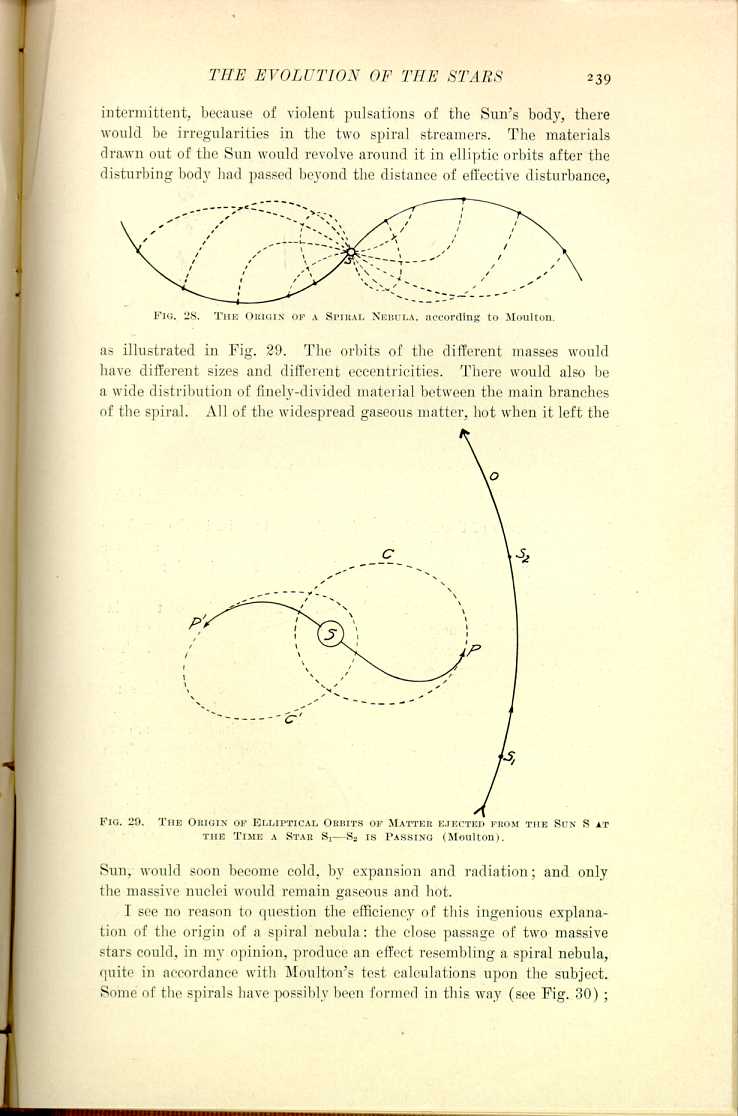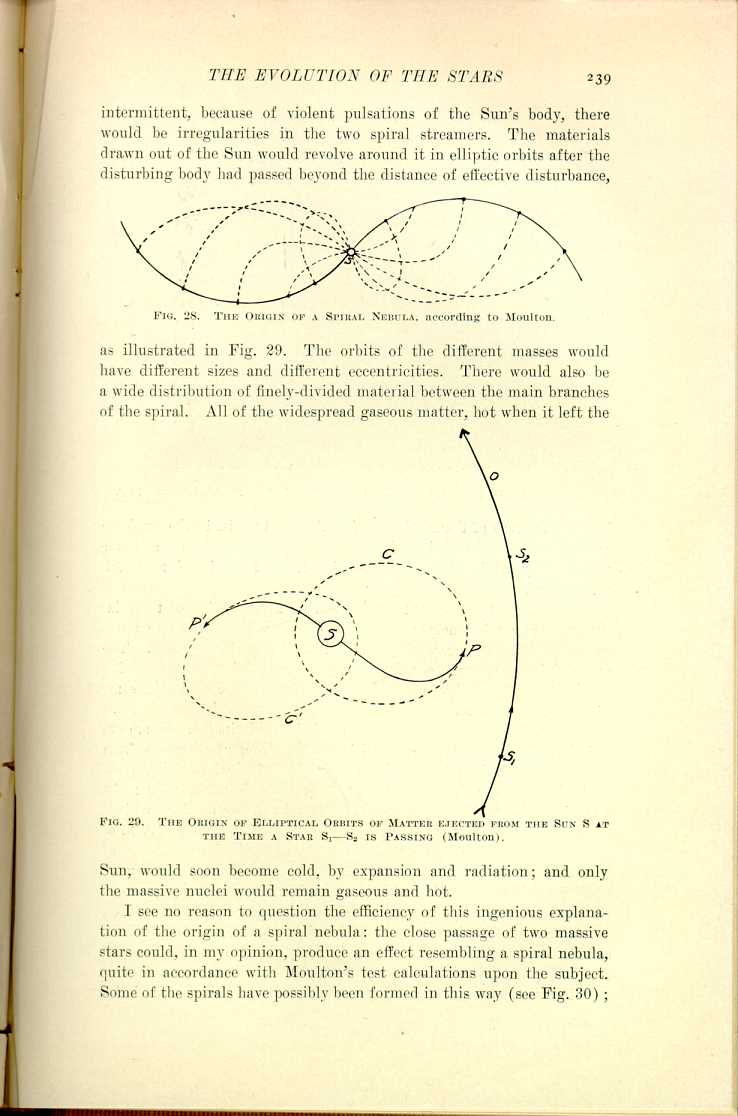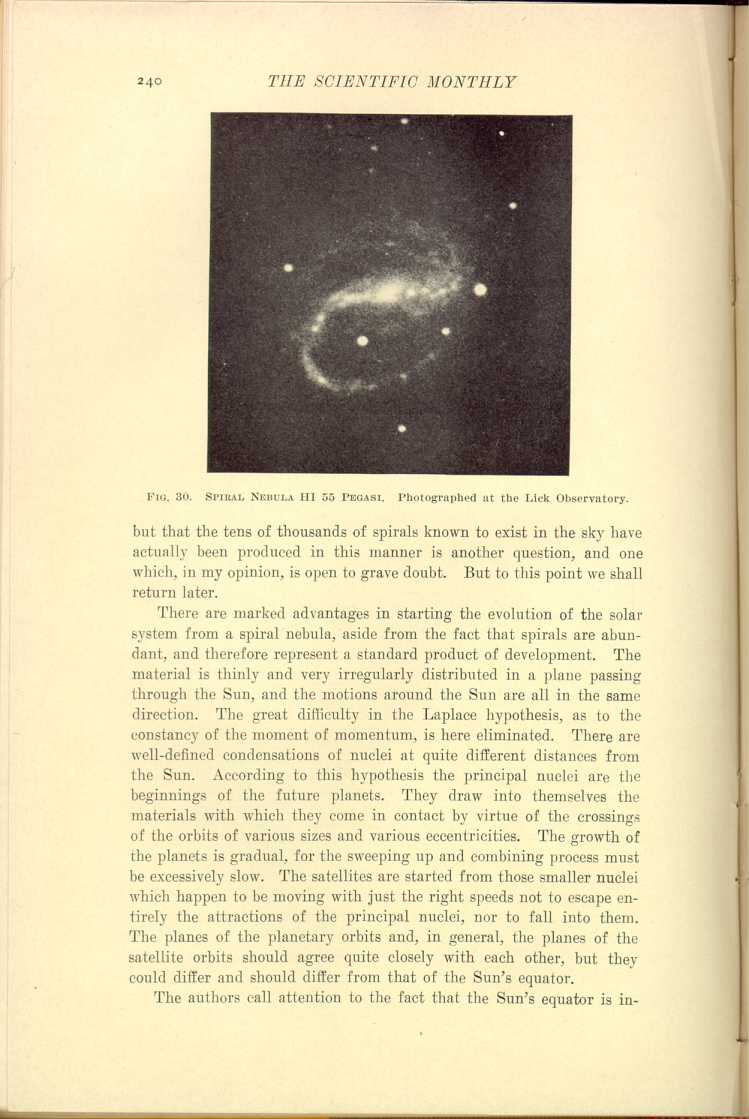| The Scientific Monthly | ||
THE PLANETESIMAL HYPOTHESIS
THE most elaborate structure yet proposed to explain the origin of the solar system is the planetesimal hypothesis by Chamberlin and Moulton. The energy which these investigators have devoted to formulating and testing this hypothesis, in the light of the principles of mechanics, has been commensurate with the importance of the subject. They postulate that the materials now composing the Sun, planets, and satellites, at one time existed as a spiral nebula, or as a great spiral swarm of discrete particles, each particle in elliptic motion about the central nucleus. The authors go further back and endeavor to account for the origin of the spiral nebula, but this phase of the subject is not vital to their hypothesis. However, it conduces to clearness in presenting their hypothesis to begin with the earlier process.
It may happen, once in a while, that two stars will collide. If the collision is a grazing one, they say, a spiral nebula will be formed. However, a fairly close approach of two stars will occur in vastly greater frequency and the effect of this approach will also be to form a spiral nebula or two such nebulæ. The authors recall that our Sun is constantly ejecting materials to a considerable height to form the prominences, and that the attractions of a great star passing fairly close to our solar system would assist this process of expulsion of matter from the Sun. A great outbreak or ejection of matter would occur not only on the side of our Sun turned toward the disturbing body, but on the opposite side as well, for the same reason that tides in our oceans are raised on the side opposite the Moon as well as on the side toward the Moon. As the Sun and disturbing star proceeded in their orbits, the stream of matter leaving our Sun on the side of the disturbing body would try to follow the other star; and the stream of matter leaving the other side of the Sun would shoot out in curves essentially symmetrical with those in the first stream. As the disturbing star approached and receded the paths taken by the ejected matter would be successively along curves such as are represented by the dotted lines in Fig. 28. At any given moment the ejected matter would lie on the two heavy lines. The matter would not be moving along the heavy lines, but nearly at right angles to them, in the directions that the lighter curves are pointing. As the ejections would not be continuous, but on the contrary

FIG. 28. THE ORIGIN OF A SPIRAL NEBULA, according to Moulton.
[Description: Illustration of the origin of a spiral nebula. In design, the lines combine to look like a bow tie.]
FIG. 29. THE ORIGIN OF ELLIPTICAL ORBITS OF MATTER EJECTED FROM THE SUN S AT THE TIME A STAR S1—S2 IS PASSING (Moulton)
[Description: Illustration of the origin of elliptical orbits of matter ejected from the sun. In design, the lines combine to look like a figure eight turned on its side.]I see no reason to question the efficiency of this ingenious explanation of the origin of a spiral nebula: the close passage of two massive stars could, in my opinion, produce an effect resembling a spiral nebula, quite in accordance with Moulton's test calculations upon the subject. Some of the spirals have possibly been formed in this way (see Fig. 30);

FIG. 30. SPIRAL NEBULA HI 55 PEGASI. Photographed at the Lick Observatory.
[Description: Photograph of a spiral nubula.]There are marked advantages in starting the evolution of the solar system from a spiral nebula, aside from the fact that spirals are abundant, and therefore represent a standard product of development. The material is thinly and very irregularly distributed in a plane passing through the Sun, and the motions around the Sun are all in the same direction. The great difficulty in the Laplace hypothesis, as to the constancy of the moment of momentum, is here eliminated. There are well-defined condensations of nuclei at quite different distances from the Sun. According to this hypothesis the principal nuclei are the beginnings of the future planets. They draw into themselves the materials with which they come in contact by virtue of the crossings of the orbits of various sizes and various eccentricities. The growth of the planets is gradual, for the sweeping up and combining process must be excessively slow. The satellites are started from those smaller nuclei which happen to be moving with just the right speeds not to escape entirely the attractions of the principal nuclei, nor to fall into them. The planes of the planetary orbits and, in general, the planes of the satellite orbits should agree quite closely with each other, but they could differ and should differ from that of the Sun's equator.
The authors call attention to the fact that the Sun's equator is inclined
Now the chance for a disturbing star's passing around our Sun in a plane making a large angle, say from 45° to 90°, with the Sun's equator, is much greater than for a small angle 0° to 45°. The chances are greatest that the angle will be 90°. Only those disturbing stars which approach our Sun precisely in the plane of the Sun's equator could move around the Sun in this plane. All those approaching along any line parallel to the Sun's equatorial plane, but lying outside of this plane, and all those whose directions of approach make any angle whatever with the equatorial plane, would find it impossible to move in that plane. That the angle under this hypothesis is only 7° is surprising, though, as we are dealing with but a single case, we can not say, I think, that this militates either for or against the hypothesis. We are entitled to say only that unless the approach was so close as to cause disturbances in our Sun to relatively great depths, the angle referred to would have only one chance in ten or fifteen or twenty to be as small as 7°. Any disturbance which succeeded in taking out of the Sun only 1/7 of 1 per cent. of its mass could scarcely succeed in shifting the axis of rotation of the remaining 99 6/7 per cent. very much, I think. If the angle were 30° or 50° or 80°, instead of 7°, the case for the planetesimal hypothesis would be somewhat stronger.
A remarkable fact concerning the Sun is that the equatorial region rotates once around in a shorter time than the regions in higher latitudes require. The rotation period of the Sun's equator is about 24 days; the period at latitude 45° is 28 days; and at 75°, 33 days. The planetesimal hypothesis attributes this equatorial acceleration to the falling back into the Sun of the materials which had been lifted out to a short distance by the disturbing body, and to the forward-rushing tide raised in the equatorial regions by the disturbing body. This may well have occurred. However, we must remember that the same phenomenon exists certainly in Jupiter and Saturn, and quite probably in Uranus and Neptune; that is, in all the bodies in the system that are gaseous and free to show the effect. It seems to be the result of a
If the spiral nebulæ have been formed in accordance with Chamberlin and Moulton's hypothesis, the secondary nuclei in them must revolve in a great variety of elliptic orbits. The orbits would intersect, and in the course of long ages the separate masses would collide and combine and the number of separate masses would constantly grow smaller. Moulton has shown that in general the combining of two masses whose orbits intersect causes the combined mass to move in an orbit more nearly circular than the average orbit of the separate masses, and in general in orbit planes more nearly coincident with the general plane of the system. Accordingly, the major planets should move in orbits more nearly circular and more nearly in the plane of the system than do the asteroids; and so they do. If the asteroids should combine to form one planet the orbit of this planet should be much less eccentric than the average of all the present asteroid eccentricities, and the deviation of its orbit plane should be less than the average deviation of the present planes. We can not doubt that this would be the case. Mercury and Mars, the smallest planets, should have, according to this principle, the largest eccentricities and orbital inclinations of any of the major planets. This is true of the eccentricities, but Mars's orbit plane, contrarily, has a small inclination. Venus and the Earth, next in size, should have the next largest inclinations and eccentricities, but they do not; Venus's eccentricity is the smallest of all. The Earth's orbital inclination and eccentricity are both small. Jupiter and Saturn, Uranus and Neptune, should have the smallest orbital inclinations; their
The fact that the disturbing body drew 225 times as much matter a great distance to form the four large planets as it drew out a short distance to form the four small planets and the asteroids seems difficult of explanation on the planetesimal hypothesis. However, this distribution of matter is at present a difficulty in any of the hypotheses. The planetesimal hypothesis explains well all west to east rotations of the planets on their axes, but to make Uranus rotate nearly at right angles to the plane of the system, and Neptune in a plane inclined 135° to the plane of the system, is a difficulty in any of the hypotheses, unless special assumptions are made to fit each case.
The authors succeed well, I think, in showing that the satellites should prefer to revolve around their planets in the direction of the planetary revolution and rotation, especially for close satellites, and, on the basis of special assumptions, in the reverse direction for satellites at a greater distance. They show that the chances favor small eccentricities for satellites revolving about their planets in the west to east, or direct sense, and large eccentricities for satellites moving in retrograde directions. The inner satellite of Mars and the rings of Saturn make no special difficulty under the planetesimal hypothesis.
The evidence of the comets, as bona fide members of the solar system which approach the Sun almost, and perhaps quite, indifferently from all directions, is that the volume of space occupied by the parent structure of the system was of enormous dimensions, both at right angles to the present principal plane of the system and in that plane. We are accustomed to think of the spiral nebulæ as thin relatively to their major diameters. To this extent the planetesimal hypothesis does not furnish a good explanation of the origin of comets, unless we assume that a small amount of matter was widely scattered in all directions around the parent spiral; and this conception leads to some apparent difficulties. The origin of the comets is difficult to explain under any of the hypotheses.
| The Scientific Monthly | ||